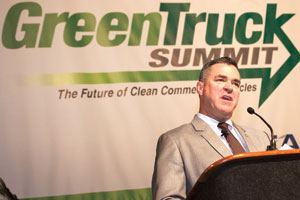Looking Beyond Diesel to Fuels of Tomorrow

This story appears in the May 1 print edition of Transport Topics.
INDIANAPOLIS — Diesel fuel dominates the commercial truck world today and will continue to do so in the near future, but greenhouse gas regulations will force the industry to use it more efficiently and eventually could push fleets toward other, cleaner fuels, industry executives said here at the Green Truck Summit.
Advances in diesel engine design have drastically reduced emissions of nitrogen oxides and particulate matter, but greenhouse gas still is a challenge, said Wilfried Achenbach, senior vice president of engineering and technology for Daimler Trucks North America.
“There is no easy answer” to controlling greenhouse gas emissions, he said at the March 14-16 event, held in conjunction with The Work Truck Show.
The U.S. Environmental Protection Agency and the National Highway Traffic Safety Administration have set increasingly stringent greenhouse gas emission standards for commercial vehicles through 2027. Various speakers at the summit provided examples of the inroads being made by alternative fuels as the industry wrestles with these goals.
UPS Inc., for example, is exploring the use of a variety of fuels, including propane, ethanol, natural gas and biomethane or renewable natural gas, as well as electricity, said Mike Britt, director of maintenance and engineering for UPS’ international ground fleet operations. Out of the more than 100,000 UPS vehicles in service worldwide, 8,100 are propelled by something other than diesel or gasoline.
The use of all of these alternatives to diesel is advancing, but a great deal of the attention at the Green Truck Summit was given to the potential of achieving zero emissions through the use of electric vehicles and hydrogen fuel cells.
“Potential” is the key word, because these technologies still face considerable hurdles. Battery-powered electric vehicles may have zero tailpipe emissions, but the emissions that come from generating the electricity used to charge the battery may be just as damaging to the environment as those from a diesel engine.
“Electricity is not just coming out of the wall,” DTNA’s Achenbach said. “We are still operating on coal.”
Two-thirds of the nation’s energy production for the electrical grid is based on using fossil fuels, and changing that mix would be a major undertaking, he said. “It needs political will, commitment from society, and it will cost money. This doesn’t come for free.”
Hydrogen fuel cells may offer a path forward.
Nikola Motor Co. unveiled a zero-emission, hydrogen-electric Class 8 truck in December, sparking conversations within the industry about the possibilities of hydrogen as a power source for longhaul trucking. The startup manufacturer aims to launch that truck in mid-2020.
UPS, which ranks No. 1 on the Transport Topics Top 100 list of the largest for-hire carriers in the United States and Canada, also sees potential in the technology.
“We are definitely drinking the hydrogen cocktail,” UPS’ Britt said. “We get it. We understand that hydrogen fuel cells propelling electric vehicles is the pathway to zero emissions. We’ve been working on this fuel-cell project since about 2010.”
Britt also spoke about the different maintenance requirements for an electric vehicle versus the traditional internal combustion engine.
“Maintenance of fuel cells can be very simple, and very inexpensive,” he said. “The cost of this has nosedived in the last four years.”
He explained that internal combustion engines contain more than 1,000 moving parts, while electric motors have about seven.
“So look at the difference in the maintenance in those components,” Britt said. “Electric motors are very simple. We think we’re getting very close to electrification for our Class 6 application.”
However, the challenge right now is the manner of producing hydrogen.
“If you generate the hydrogen through electrolysis with electricity that’s coming from a coal power plant, you’re nowhere,” said Wayne Eckerle, vice president of corporate research and technology at engine maker Cummins Inc. “If you generate the hydrogen with renewable sources — solar, wind, whatever — you’ll get low greenhouse gas.”
UPS’ Britt pointed to other ways of producing hydrogen.
“Not all of it is through electrolysis,” he said. “We really believe that trash-to-gas is a great pathway to getting there, meaning digesters at waste recovery points and landfills.”
In Britt’s view, the technology has reached a turning point.
“It isn’t a technical bridge any longer,” he said. “Now it’s a tactical or economic bridge to getting there. So we do believe that renewable hydrogen is the way to go.”
However, those tactical and economic challenges for hydrogen still are significant, said Cummins’ Eckerle. The total cost of ownership for hydrogen technology is much higher than that of diesel, he said.
“Hydrogen doesn’t come close to the overall operating efficiencies you get with fossil fuels,” he said. “It’s not even in the same ballpark.”
There also are issues related to storage and infrastructure.
“There’s really nothing set up today,” Eckerle said. “It just doesn’t exist, and to build that infrastructure will take a lot of time.”
Efforts are being made at the U.S. Department of Energy to bring down the cost of generating hydrogen, said Reuben Sarkar, deputy assistant secretary for transportation at DOE’s Office of Energy Efficiency & Renewable Energy.
“We’re focused on what we call ‘advanced water splitting’ in the Department of Energy — not just conducting electrolysis but actually coming up with cheaper ways and better ways to split a molecule of water into the fuel that we need,” he said.
Another path to reduced emissions involves changing the way electricity is generated, and California is focused on this task.
“In California right now, 20% of our electricity is generated by renewable sources,” said Jack Kitowski, chief of the mobile source control division of the California Air Resources Board. “It is required to be 33% by 2020 and 40% by 2030.”
At the national level, DOE also is working to modernize the grid, Sarkar said, “which means we’re going to be bringing a lot more clean electrons on from renewable resources.”
In Sarkar’s view, we’re experiencing a “revolution in clean energy.”
Years and years of investments in research and development have created a repeating trend where the cost of technology falls and the performance goes up, he said. The result today is “a dramatic uptick in the areas of wind, utility-scale solar and distributed solar. Those clean electrons are beginning to become available.”
The ability to use electricity from the grid to power vehicle engines relies on the use of batteries, and here again, technology is advancing rapidly.
“Batteries have continued to fall in cost, and they are the underpinnings of zero-emission vehicles,” Sarkar said. “Prices have come down dramatically, but they have to come down quite a bit more. It will take us another decade of walking down that cost curve, but we see a clear line of progress to get there.”
CARB’s Kitowski said California wants to increase the use of electric vehicles where it makes sense.
“It doesn’t make sense right now in linehaul trucks,” he said. “That would be a faulty premise — to establish a whole pack of batteries in a truck. It does make sense for transit buses, last-mile delivery and local trucks, and airport shuttle buses.”
Even though alternative fuels are advancing, diesel still is king.
“People say diesel is dead, but I don’t believe it,” DTNA’s Achenbach said.
Although battery technology is improving at a rapid clip, batteries still cannot compete with diesel in terms of weight and the amount of space required, he said. “Diesel has a lot of energy stored in a little bit of volume and weight.”
Diesel engines also have the advantages of high torque and a long lifetime, and run on fuel that is easily accessible, Achenbach added. “It’s very easy to refill — just put the nozzle in. It’s readily available. We have a fully established distribution network.”
Average fuel efficiency for diesel engines has risen over the past two decades, and it will continue to improve, which in turn reduces greenhouse gas emissions.
“In the foreseeable future, 10 mpg will become the new standard for tractor-trailers,” Achenbach said. “I don’t believe we’ll have to wait another 10 years. This is going to happen faster.”
The rise of alternative fuels may be inevitable, and there is debate about which fuel will dominate, but the general consensus is that the change will take time.
Steve Tam, vice president at ACT Research, shared a historical perspective on the industry’s fuel choice.
“Diesel has not always been the dominant fuel in the commercial vehicle space,” Tam said. “It was actually about a 40-year transition from gasoline.”
The engines, the infrastructure, the parts and the technicians weren’t available everywhere, so it took time for the industry to fully embrace diesel. However, the move did occur because diesel’s density of energy and efficiency made it the perfect choice at the time, Tam said.
It was a “silver bullet,” he said, but “now, we’re not going to have a silver bullet. We’re going to have silver buckshot.”
Tam predicts that the industry will embrace a variety of fuels depending on the nature of the application.
Eckerle, of Cummins, also predicted that change will come slowly.
“The energy for transportation predominately comes from fossil fuels today,” he said. “Going forward, our infrastructure is going to have to change significantly if we’re going to move to other sources of energy. It’s a great big battleship that we have to turn, and it’s not going to happen very quickly.”




